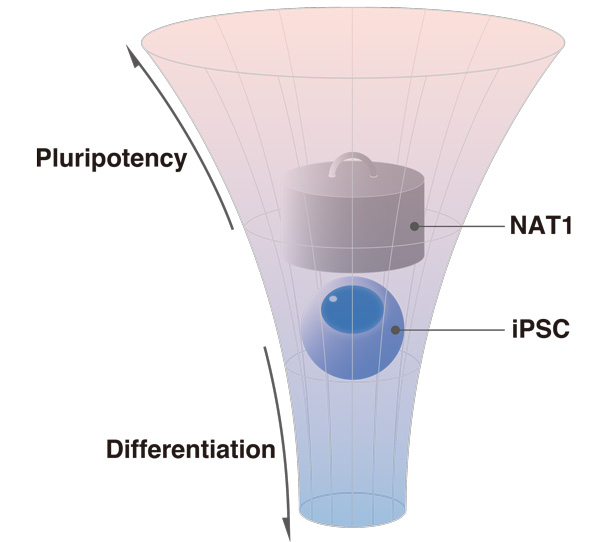
News & Events
News & Events
News
December 28, 2016
The makings of better human stem cells

Nat1 promotes differentiation and destabilizes the pluripotent state.
The Yamanaka lab finds Nat1 may improve stem cell quality
Although they have come to define his career, CiRA Director and Gladstone Institutes Principle Investigator Shinya Yamanaka describes iPS cells as an outcome of a much greater scientific interest. "My scientific research has been about cell pluripotency. I have been searching for factors like Nat1 (Novel APOBEC1 target #1, also known as eIF4G2) that regulate pluripotency."
Many people do not associate Nat1 with Yamanaka, but it has been a major theme in his research for more than two decades, dating back to the time he was first identified Nat1 while working at the Gladstone Institutes. In its most recent publication, his lab at CiRA reports new insights on how Nat1 regulates pluripotency in mouse ES cells. The study can be read in the Proceedings of the National Academy of Sciences.
Pluripotency describes a state in which a cell can differentiate into any other cell type. Scientists have since discovered many states of pluripotency. Based on the condition the cell is cultured, a mouse ES cell can take one of three pluripotent states: ground, naïve, or primed.
"The ground state is best for regenerative medicine, because it has the highest pluripotency and efficiency at differentiating into other cells," said Hayami Sugiyama, a researcher in the Yamanaka lab and first author of the study. In humans, however, no ground state ES cells are known, and naïve state ES cells have only recently been created. "We are using mouse cells to find factors that could help us acquire ground pluripotency in human cells," said Sugiyama.
Previous work from the Yamanaka lab and others has already revealed Nat1 as such a factor. In particular, mouse ES cells in which Nat1 was deleted (Nat1-null cells) showed properties similar but not identical to those of ground state even though the cells were cultured in conditions appropriate for the naïve state. In their latest paper, the group identifies two gene targets of Nat1 that were suppressed in Nat1-null cells, Map3k3 and Sos1. Interestingly, the translation but not the transcription of these genes was changed. This observation suggests that inhibiting the activity of the proteins made from the genes could be crucial in acquiring the ground state in mouse cells.
These findings do not assure that Nat1 will clarify ground pluripotency in human cells. Nevertheless, Sugiyama believes that, "using Nat1, we can find signaling pathways in mouse cells that might also work in human cells."
Paper Details
- Journal: Proceedings of the National Academy of Sciences
- Title: Nat1 promotes translation of specific proteins that induce differentiation of mouse embryonic stem cells
- Authors: Hayami Suigyama1, Kazutoshi Takahashi1,2, Takuya Yamamoto1,3,4, Mio Iwasaki1, Megumi Narita1, Masahiro Nakamura1, Tim A Rand2, Masato Nakagawa1, Akira Watanabe1,3,4, and Shinya Yamanaka1,2
- Author Affiliations:
- Center for iPS Cell Research and Application (CiRA), Kyoto University, Kyoto, Japan
- Gladstone Institutes, San Francisco, CA
- Institute for Integrated Cell-Material Sciences (iCeMS), Kyoto University, Kyoto, Japan
- Japan Agency for Medical Research and Development-CREST, Tokyo Japan






















